First off, it is necessary to distinguish between three great religious sites in SE Asia, two of which I didn’t have a clue about until I moved to China in 2017. They are all UNESCO World Heritage sites and absolutely magnificent, bucket list destinations but for different reasons. Borobudur in Yogyakarta, Indonesia, is the world’s single largest Buddhist temple. Bagan, Myanmar is the world’s greatest collection of Buddhist temples, stupas and monasteries at over 2,500 (originally 10,000+). Angkor Wat in Siem Reap, Cambodia, is the largest religious structure in the world according to Guinness World Records. It covers just over 400 acres and was originally built as a Hindu temple before being converted to a Buddhist temple. I will post about my visits to the other two eventually, but for now - Angkor Wat.
What I didn’t tell you in Cambodia - Part 1 is that I never made it to Angkor Wat on my first visit. The day after I met Scarface and his tuk-tuk driver, I got an email from my school in China asking me to come back to work a few days early. So off I went back to China feeling quite disappointed, vowing to return at the next opportunity. I didn’t have to wait too long for my next chance as I got a couple of weeks off at the end of the year. I booked a short stay in Macau for the New Year’s celebration, followed by a week in Siem Reap.
When I arrived in Siem Reap this time, I was prepared. I had contacted Ponleak, Scarface’s tuk-tuk driver, in advance and booked his services for two days. One day would be spent seeing Angkor Wat and the nearby temples. The second day would be reserved for watching the sunrise at Angkor Wat, a very popular activity which entails getting up at 4 am in order to secure a good viewing position. After that I would have time to visit a few more temples or simply linger at Angkor Wat. You can buy the entrance tickets online or at the ticket office in Siem Reap - I bought the $62 USD three day ticket as the $37 USD one day ticket doesn’t really allow enough time to see Angkor Wat plus all the noteworthy neighbouring temples without rushing. There is also a $72 seven day option but that’s for the die-hards - remember you are smack dab in the middle of a tropical country, with mid-day temps often approaching 35 degrees (95 Fahrenheit) plus dripping humidity. After my two days of sightseeing, I wanted to hang out near a swimming pool, of which luckily there are plenty in land-locked Siem Reap!
At 7am the next day, we were off in Ponleak’s sputtering tuk-tuk to Angkor Wat. Ponleak (or Pony as he preferred to be called), said that tourism had tripled in Siem Reap in only ten years, enabling him to buy his own vehicle and provide an increasingly comfortable lifestyle for his wife and three children. Of course this was just before Covid and 5 years later, Cambodia’s tourist arrivals still haven’t reached 2019 levels, although it has substantially recovered from the complete shutdown of 2020-2021. Siem Reap even has a much-expanded brand new international airport which opened a day after my last arrival in October 2023. Built by China, of course.
Angkor Wat means “City of Temples” and was built over a period of 28 years with a completion date of 1150, when the King of the Khmer Empire who commissioned it, died. Over 300,000 workers were involved in its construction, utilizing 6000 elephants! What’s most amazing is it is all stone, quarried over 50 km. away and transported by river, and almost all of the stone is covered with beautiful, intricate carvings containing narrative or decorative details. Originally a Hindu Temple, starting in 1177 it was gradually converted to a Buddhist Temple because the following King’s wife was Buddhist. Happy wife, happy life! Around the 16th century, Angkor Wat was largely abandoned, which is still a bit of a mystery to this day although it was sacked and heavily looted by the Siamese at the end of the 15th century, with over 90,000 Khmer forcibly moved to Siam.
The first European to see it was a Portuguese friar who visited in 1586. He remarked, “it is of such extraordinary construction that it is not possible to describe it with a pen, particularly since it is like no other building in the world. It has towers and decoration and all the refinements which the human genius can conceive of." For hundreds of years it lay neglected and overgrown in the jungle until in 1860, it was “rediscovered” by French explorer Henri Mouhot who wrote, “One of these temples, a rival to that of Solomon, and erected by some ancient Michelangelo, might take an honorable place beside our most beautiful buildings.” Soon afterwards, the French invaded Siam (Thailand) and made Cambodia a protectorate, allowing it to take back Siem Reap and the rest of northern Cambodia from the Siamese.
Restoration work was led by the French from 1908 to the early 1970’s when, once again, Angkor Wat was abandoned due to the civil war. Khmer Rouge troops camped out in the area caused a fair amount of damage by burning any remaining wood, there were firefights between the Vietnamese Army and the Khmer Rouge in the late 1970’s which created lots of bullet holes and in the 1980’s, art thieves based in neighbouring Thailand looted the site causing a lot of damage. Finally in 1992, Angkor Wat received UNESCO World Heritage status and an urgent global appeal from the Cambodian Royal family for help in saving it. In 1993, there were 7,000 hardy tourists - now 2.5 million visit annually.
As we approach Angkor Wat we encounter the giant, water-filled moat which surrounds it. It is really impressive - 5 km in length and almost 200 meters wide! Built in the 1100’s, no less! Pony drops me off near the long stone walkway which leads to the Temple complex and we agree to meetup in 2 hours. He suggests leaving my snacks with him as there are monkeys to contend with and sure enough I am soon being observed with immense curiosity by a gang of macaques as I proceed down the walkway. In fact, the monkeys are a major attraction for some local YouTubers and this has caused problems with the monkeys being harassed.
As I approached the main temple, I experienced the sense of awe you get when you are visiting some place that’s simply extraordinary in the world. The Portuguese friar nailed it when he said it is impossible to describe it with a pen. Uniquely beautiful not just because of the construction details or size but also because of its gorgeous setting in the jungle; simply awe-inspiring and wonderful that such an ancient culture was so sophisticated to create such a magnificent structure and work of art.
After a couple of delightful hours just wandering around the massive site and enjoying the spectacle of it all, I headed back to meet Pony. From here we would be visiting several famous temples in the vicinity for the rest of the day. You really need to either use a motorbike or rent a tuk-tuk driver for the day (a very reasonable $20 USD) to visit the other temples as they are spread out over many kilometers, too far and too hot to walk between. Go early in the morning to avoid the heat and the bus tour crowds. One other thing to note, no matter how hard you try not to, you will get lost. More about that later.
Now let it be said that there are a ridiculous number of amazing temples in the Siem Reap region and even just around Angkor Wat. Rather than rushing around to as many as possible I asked Pony to take me to his Top 5. All of these temples are included in the admission ticket to Angkor Wat. There are two loops you can take around the Angkor Wat temple complex. The small loop is 17 km. and the big loop is 26 km. We took the big loop but didn’t stop at every temple. First we headed for the iconic Bayon temple, where dozens of stone faces said to represent the Buddhist god of compassion, smile down at you from 54 gothic towers.
Next up was nearby Baphuon, a 30 meter tall, three tier temple that took 50 years to restore. It has great views over the ancient city of Angkor Thom, which at one time was the world’s largest city with a million people!
After that we hit famous Ta Prohm, the Tomb Raider temple. Here I met a park ranger full of supernatural skills including the ability to clone unsuspecting tourists like me via their smartphones.
Not spotting Lara Croft was a disappointment but next we were off to Neak Prean, a small water temple.
Now I am not doing any of these temples much justice with just a few photos/videos. Truth be told, I took over 500 photos and each one reveals beauty and wonder. Angkor Wat is off the charts in this regard. However, my favourite temple of the 5 was the last one, Pre Rup, which was actually built back in 961. Incredible engineering and craftmanship over a thousand years old.

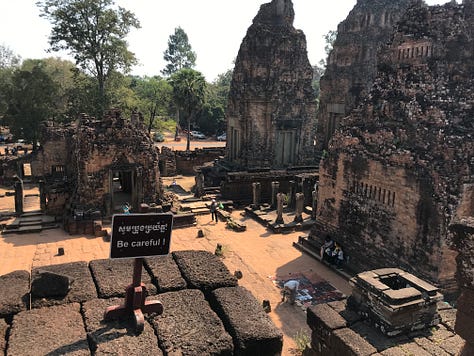



As I mentioned earlier, it is very easy to get lost at each temple and I certainly did, at every single one! The reason is that each temple has 4 entrances which lead to a center point in the temple. Some of these entrances are quite far from the drop off point. They all look the same. Pony would drop me off at an entrance but would never mention which entrance it was (ie east, west, etc) and then wait for me while I explored the temple. After I was ready to leave I would inevitably pick the wrong exit and after a 5 minute walk realize it wasn’t where I was let off. So I would have to walk back to the center of the temple and pick a different exit. Wrong again, another 5 minute walk, another exit, oops, this is the one I did before that was wrong, back again, irritation or panic sets in, depending on the time of day and how many wrong exits in a row I picked. There was swearing. This will happen to you if you get excited like I was and not pay attention to your drop off point. So it will happen.
At the end of the day we headed back to Siem Reap and I was forever grateful for finally having the opportunity to visit this treasure of the world that I had dreamed about for almost 30 years. If I was visiting SE Asia for the first time - I would put Siem Reap’s Angkor Wat at the top of my list.




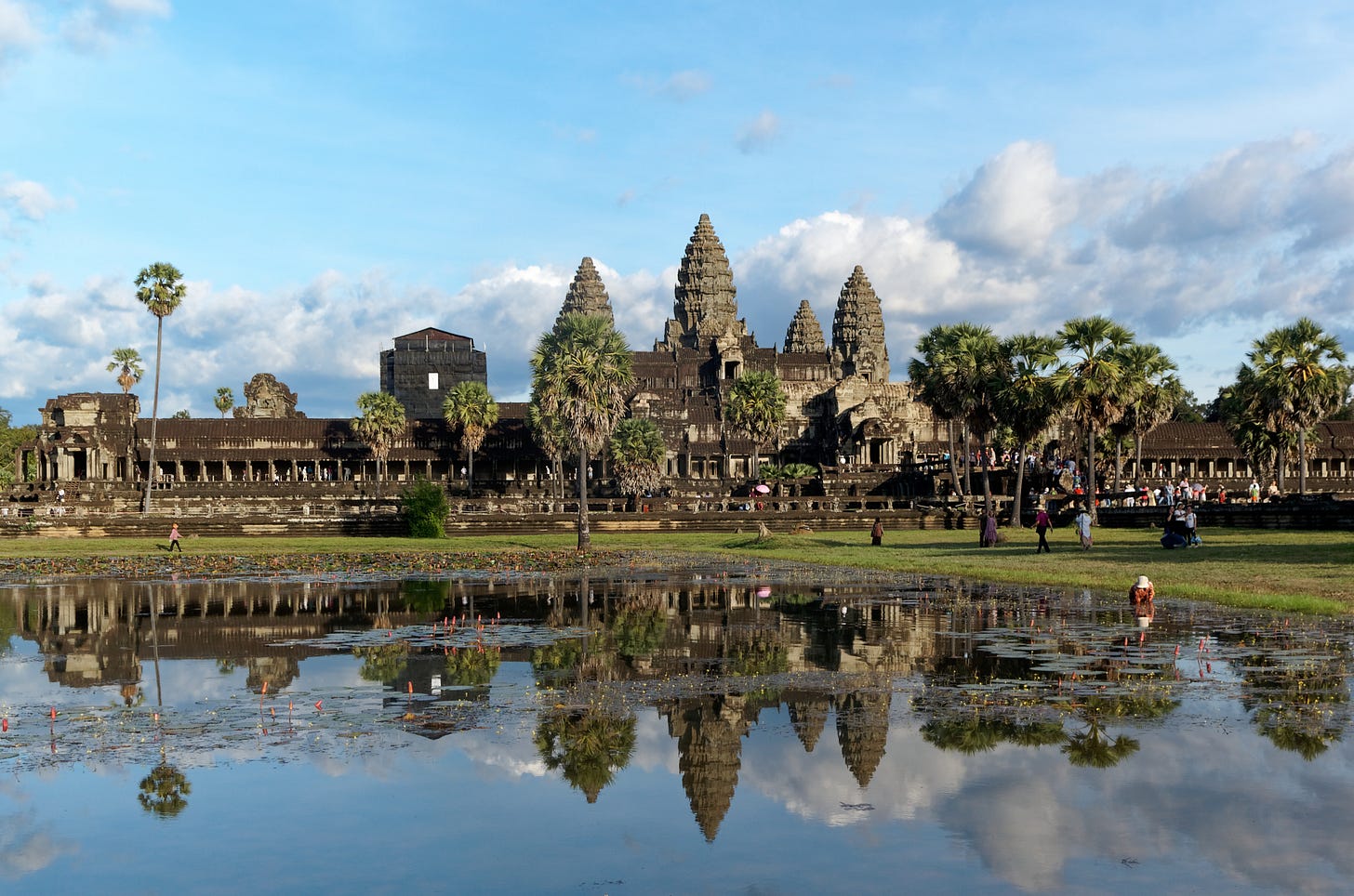

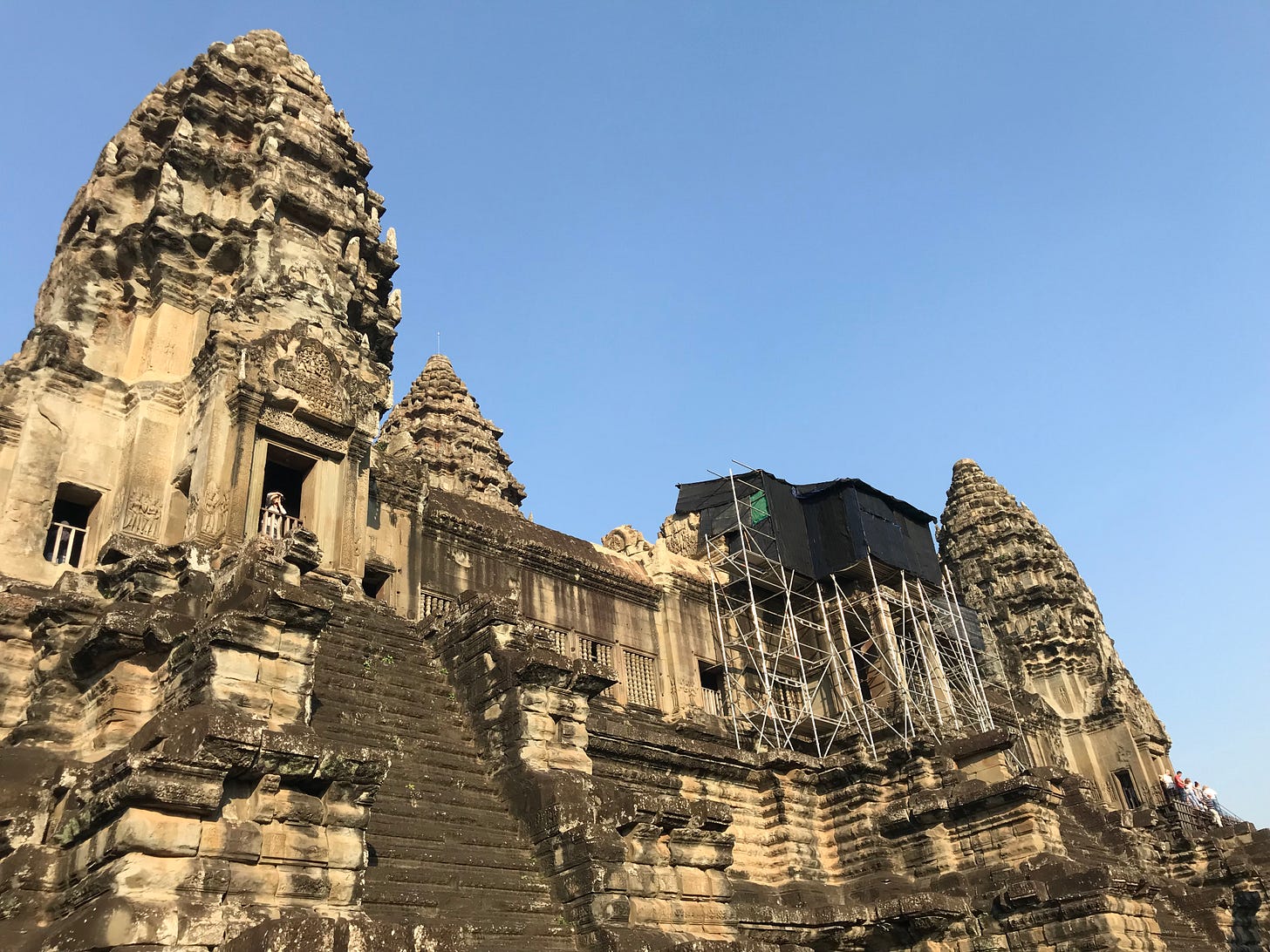
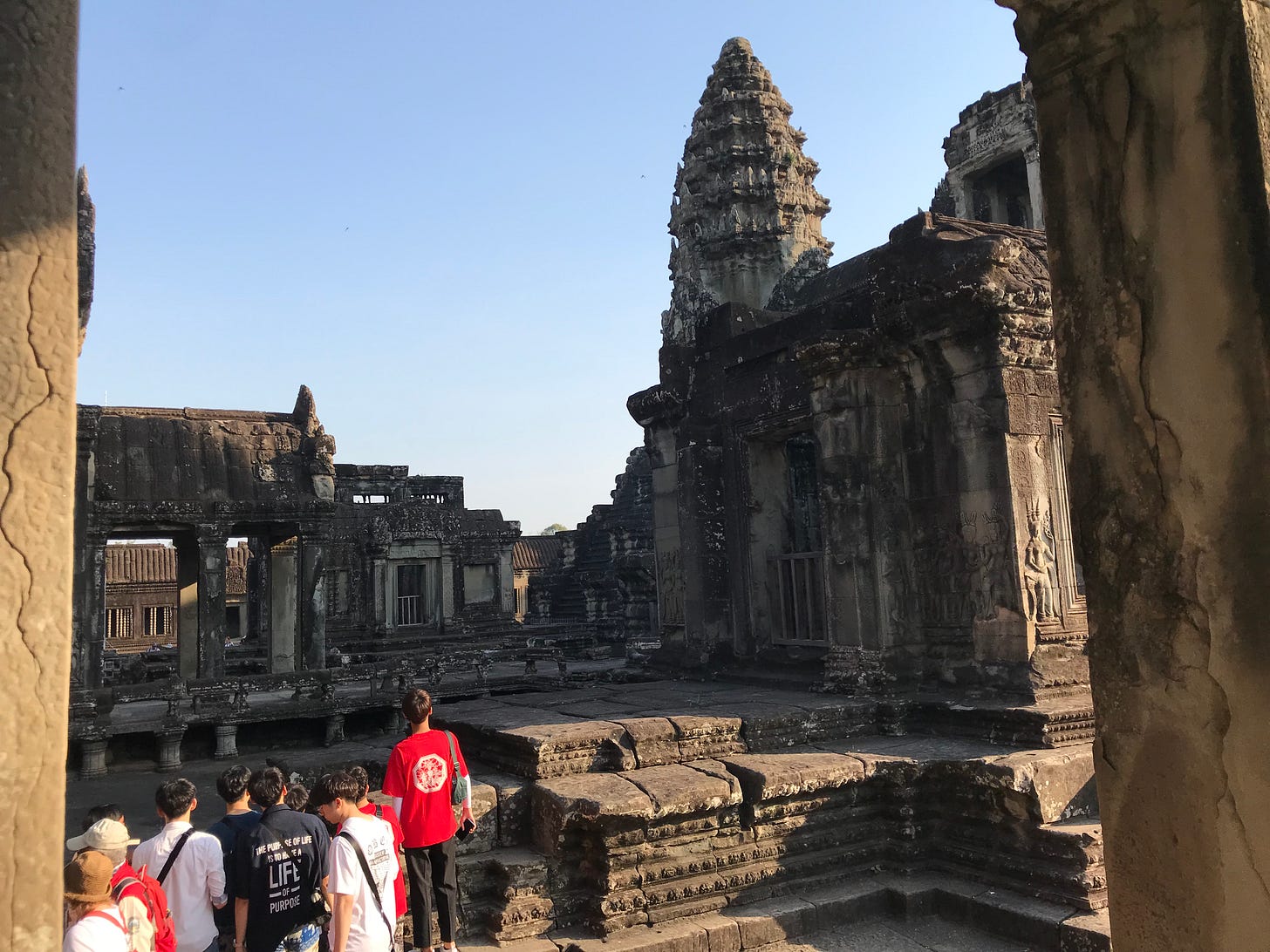
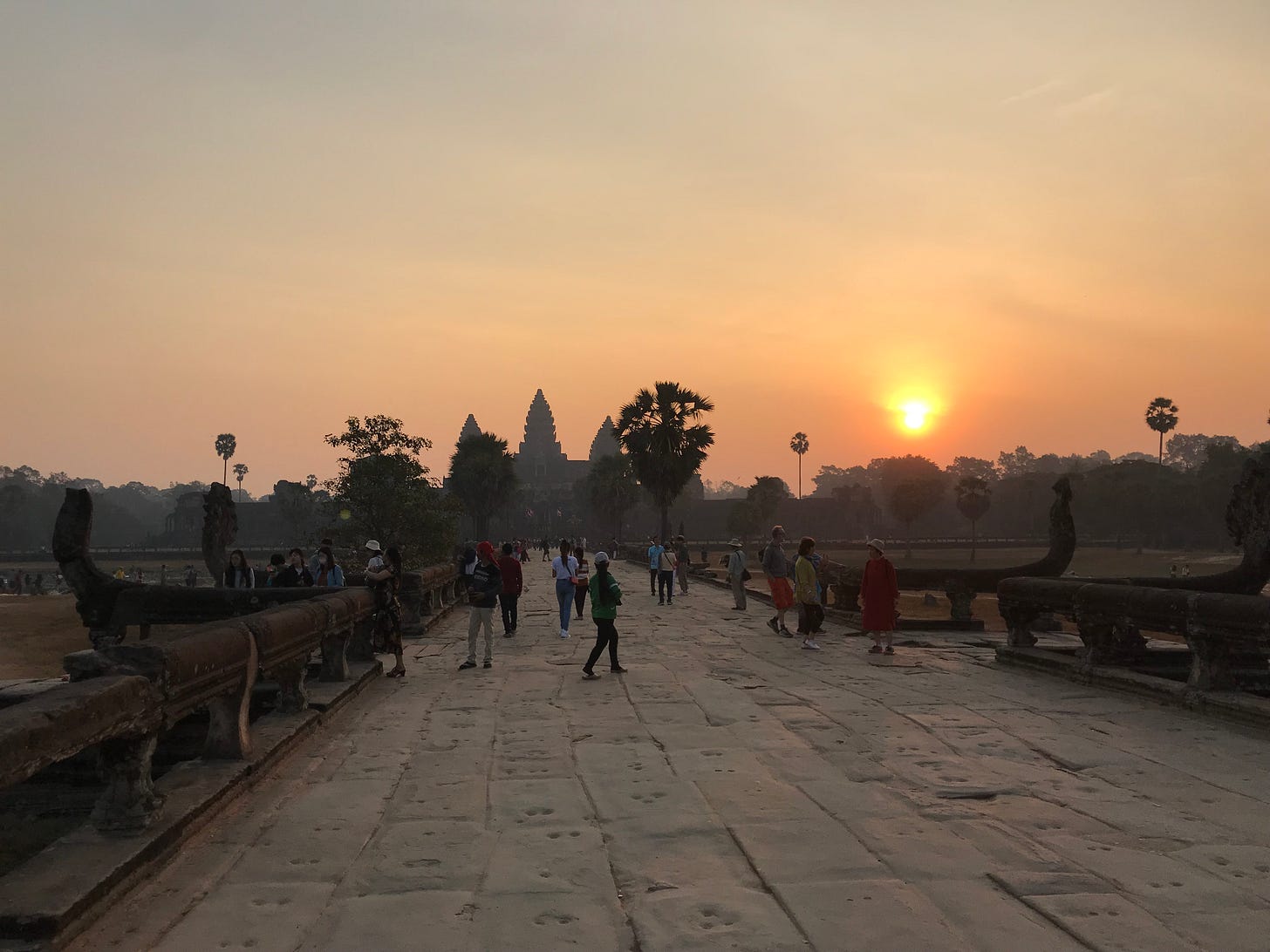

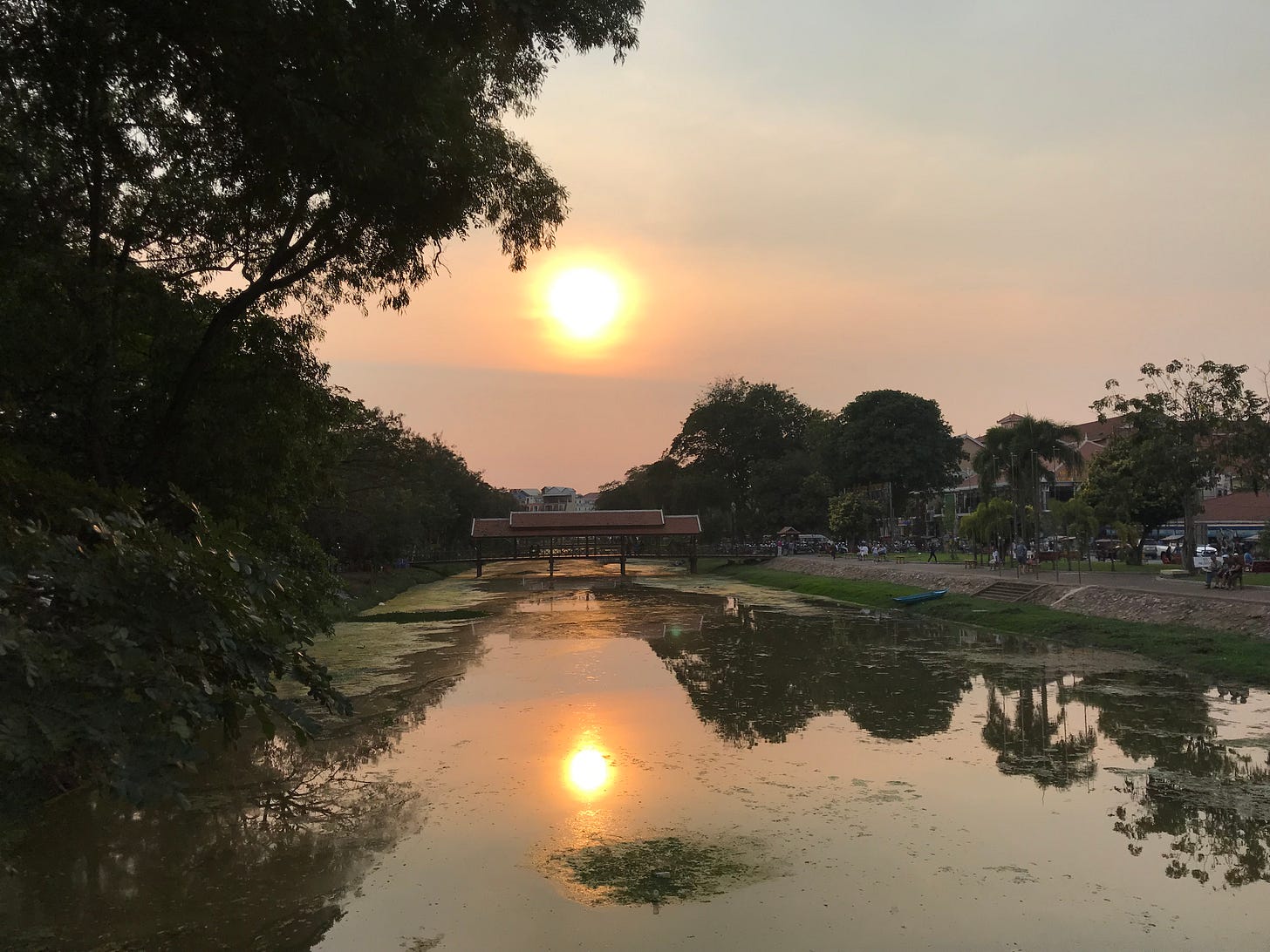


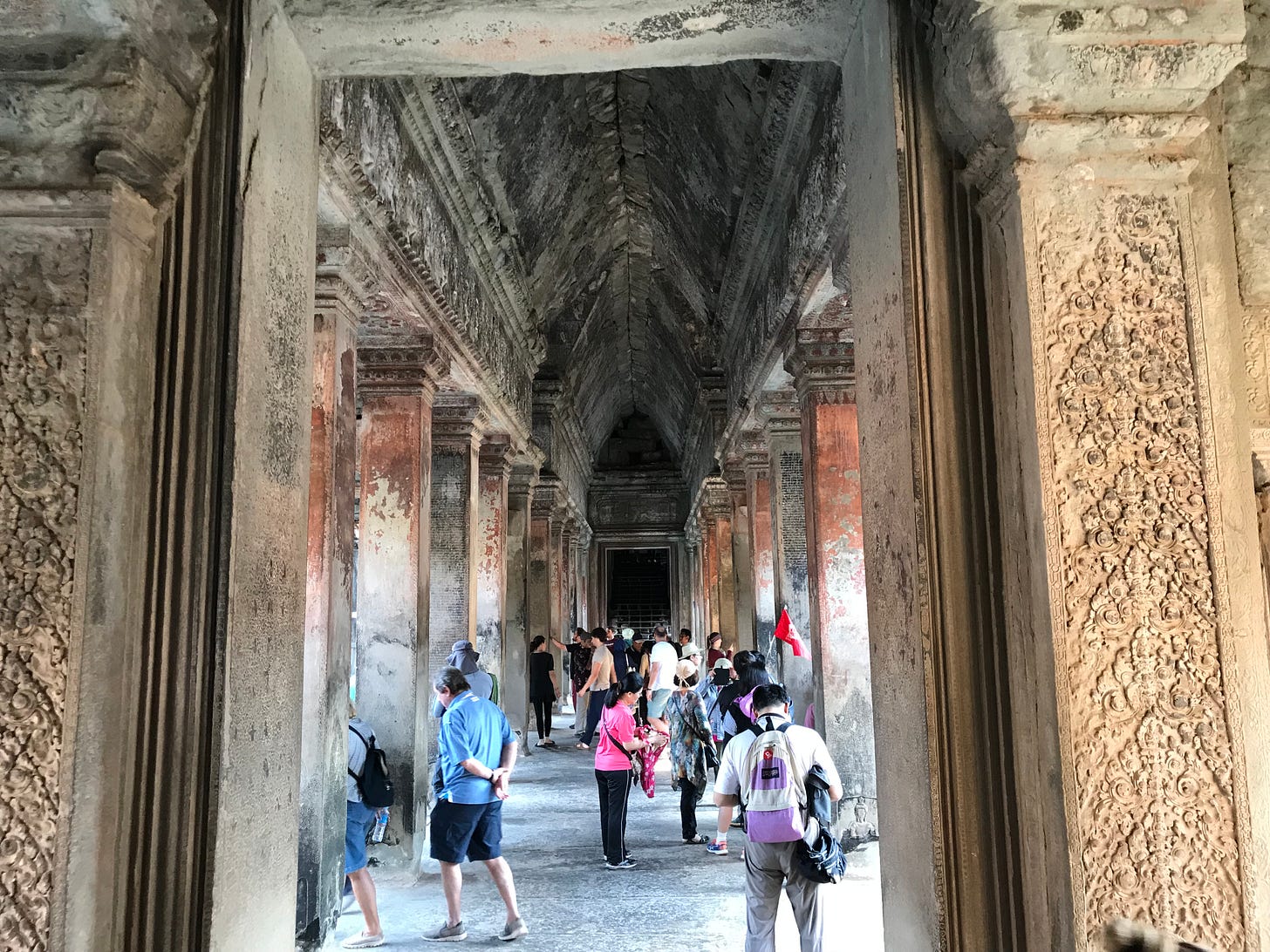



Really enjoyed that and it brought back a lot of memories of our visit in 1998.
We took a bus from Bangkok to the border and then hired a car and driver to travel the highway, which was being rebuilt by hand - no machinery. Women carrying baskets of rocks on their heads. Cambodia is where old Toyota Camrys from Thailand go to die.
The size is just indescribable. I remember walking all across the causeway to the entrance, wandering around thinking how amazing it was, stepping through and then realising I was only at the front gate and the actual temple was another long way off in the distance.
It is said they could get up to a million people inside for festivals.
We were told that the workers were actually peasants forced to work for nothing. Some died and were reportedly buried in the walls. One King is respected because he actually fed the workers!
We heard two theories about why the complex was abandoned. One is that forest over-clearing ruined the water supply for the canal city. Another is that a Vietnamese army invaded and the king moved his court south for safety.
Angkor Thom is also interesting as the royal palace. I remember a structure with a continuous intricate carving going around the four walls supposedly giving the national history. I went around several times before giving up.
It should be remembered the temples were originally painted, but the paint has been worn away. We went to one small temple which had been repainted like original and it had bright colours and scenes depicting the life of Buddha.
I really am going to have to find my photos.